#they measured the temperature of the sample
Text
'please stand in front of this toilet in the most uncomfortable and counterintuitive position possible, and then pee in this cup while under direct video surveillance'
... and then the people making me do this wonder it doesn't work?
like. if you need to observe people peeing in a cup, at least you could set up the surveillance in a way that doesn't require them to stand sideways to a toilet while holding their feet uncomfortably close together, that shouldn't be that difficult
#a grievance against society#give me therapy i'm a walking travesty#look i understand that for legal reasons and so on#but there is no legal reason for this nonsense#just have everyone fucking sit a be done with it#it took me failing for a quarter of an hour#before they decided it was permitted for me to sit down#and then after making me do this on camera#they measured the temperature of the sample#because i might have somehow replaced the sample with a different one#while under videosurveillance in an empty room#this whole setup is just an excuse to humiliate and shame people#you can't make an appointment they order you to show up#and they don't give you a time slot#so good luck if you work full time#their opening times are from 11:00 to 15:00#tuesday through friday#great for planning even if your boss is a decent person#it might take a quarter of an hour if you're the only person there#but it might equally require a few hours' waiting#because clearly people who have to get tested for drugs should be treated like shit#even if i understand wanting to punish drunk drivers#that's not a helpful thing to do#and only serves to also hurt people who have done nothing to deserve it
2 notes
·
View notes
Text
"As solar panels heat up beyond 25°C, their efficiency decreases markedly. Green roofs moderate rooftop temperatures. So we wanted to find out: could green roofs help with the problem of heat reducing the output of solar panels?
Our research compared a “biosolar” green roof — one that combines a solar system with a green roof — and a comparable conventional roof with an equivalent solar system. We measured the impacts on biodiversity and solar output, as well as how the plants coped with having panels installed above them.
The green roof supported much more biodiversity, as one might expect. By reducing average maximum temperatures by about 8°C, it increased solar generation by as much as 107% during peak periods. And while some plant species outperformed others, the vegetation flourished.
These results show we don’t have to choose between a green roof or a solar roof: we can combine the two and reap double the rewards...
How did the panels affect the plants?
In the open areas, we observed minimal changes in the vegetation cover over the study period compared to the initial planted community.
Plant growth was fastest and healthiest in the areas immediately around the solar panels. Several species doubled in coverage. We selected fast-growing vegetation for this section to achieve full coverage of the green roof beds as soon as possible.
The vegetation changed the most in the areas directly below and surrounding the solar panels. The Baby Sun Rose, Aptenia cordifolia, emerged as the dominant plant. It occupied most of the space beneath and surrounding the solar panels, despite having been planted in relatively low densities.
This was surprising: it was not expected the plants would prefer the shaded areas under the panels to the open areas. This shows that shading by solar panels will not prevent the growth of full and healthy roof gardens.

What were the biodiversity impacts?
We used environmental DNA (eDNA) surveys to compare biodiversity on the green roof and conventional roof. Water run-off samples were collected from both roofs and processed on site using portable citizen scientist eDNA sampling equipment to detect traces of DNA shed by the species on the roof.
The eDNA surveys detected a diverse range of species. These included some species (such as algae and fungi) that are not easily detected using other survey methods. The results confirmed the presence of bird species recorded by the cameras but also showed other visiting bird species went undetected by the cameras.
Overall, the green roof supported four times as many species of birds, over seven times as many arthropods such as insects, spiders and millipedes, and twice as many snail and slug species as the conventional roof. There was many times the diversity of microorganisms such as algae and fungi.
Encouragingly, the green roof attracted species unexpected in the city. They included blue-banded bees (Amegilla cingulata) and metallic shield bugs (Scutiphora pedicellata).
How did the green roof alter temperatures?
The green roof reduced surface temperatures by up to 9.63°C for the solar panels and 6.93°C for the roof surfaces. An 8°C reduction in average peak temperature on the green roof would result in substantial heating and cooling energy savings inside the building.
This lowering of temperatures increased the maximum output of the solar panels by 21-107%, depending on the month. Performance modelling indicates an extensive green roof in central Sydney can, on average, produce 4.5% more electricity at any given light level.
These results show we don’t have to choose between a green roof or a solar roof. We can combine them to take advantage of the many benefits of biosolar green roofs.
Biosolar roofs can help get cities to net zero
The next step is to design green roofs and their plantings specifically to enhance biodiversity. Green roofs and other green infrastructure may alter urban wildlife’s activities and could eventually attract non-urban species.
Our green roof also decreased stormwater runoff, removed a range of run-off pollutants and insulated the building from extremes of temperature. A relatively inexpensive system provides all of these services with moderate maintenance and, best of all, zero energy inputs.
Clearly, biosolar green roofs could make major contributions to net-zero cities. And all that’s needed is space that currently has no other use."
-via GoodGoodGood, May 12, 2024
#green#green roof#biosolar#solar power#solar panels#rooftop solar#solarpunk#native plants#australia#sydney australia#biodiversity#conservation#climate change#climate action#climate hope#global warming#temperature#climate adaptation#cooling#good news#hope
2K notes
·
View notes
Text
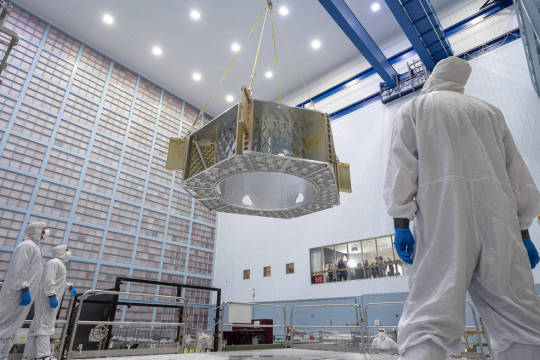
Roman's primary structure hangs from cables as it moves into the big clean room at NASA's Goddard Space Flight Center.
What Makes the Clean Room So Clean?
When you picture NASA’s most important creations, you probably think of a satellite, telescope, or maybe a rover. But what about the room they’re made in? Believe it or not, the room itself where these instruments are put together—a clean room—is pretty special.
A clean room is a space that protects technology from contamination. This is especially important when sending very sensitive items into space that even small particles could interfere with.
There are two main categories of contamination that we have to keep away from our instruments. The first is particulate contamination, like dust. The second is molecular contamination, which is more like oil or grease. Both types affect a telescope’s image quality, as well as the time it takes to capture imagery. Having too many particles on our instruments is like looking through a dirty window. A clean room makes for clean science!
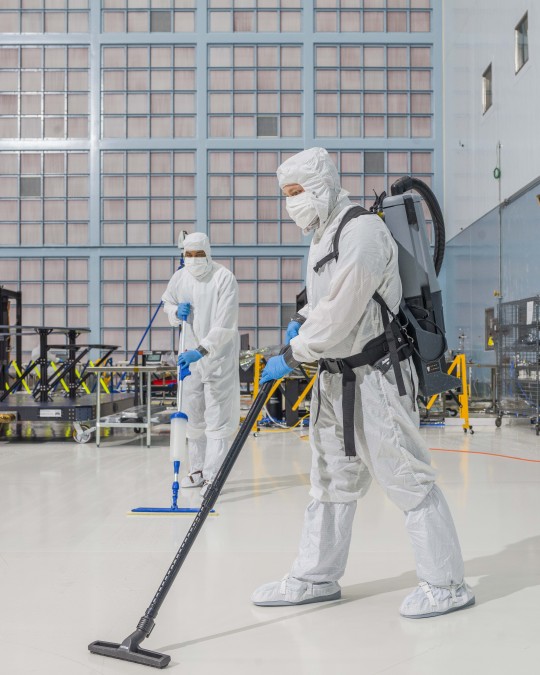
Two technicians clean the floor of Goddard’s big clean room.
Our Goddard Space Flight Center in Greenbelt, Maryland has the largest clean room of its kind in the world. It’s as tall as an eight-story building and as wide as two basketball courts.
Goddard’s clean room has fewer than 3,000 micron-size particles per cubic meter of air. If you lined up all those tiny particles, they’d be no longer than a sesame seed. If those particles were the size of 16-inch (0.4-meter) inflatable beach balls, we’d find only 3,000 spread throughout the whole body of Mount Everest!
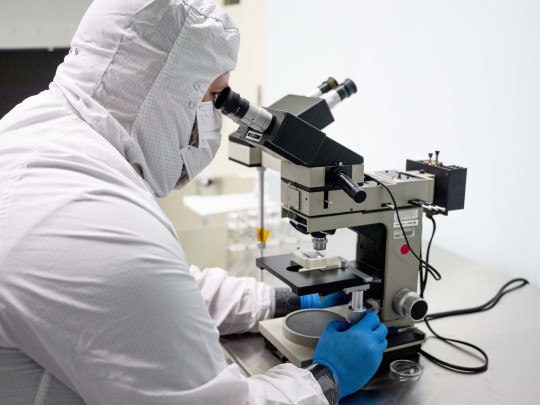
A clean room technician observes a sample under a microscope.
The clean room keeps out particles larger than five microns across, just seven percent of the width of an average human hair. It does this via special filters that remove around 99.97% of particles 0.3 microns and larger from incoming air. Six fans the size of school buses spin to keep air flowing and pressurize the room. Since the pressure inside is higher, the clean air keeps unclean air out when doors open.
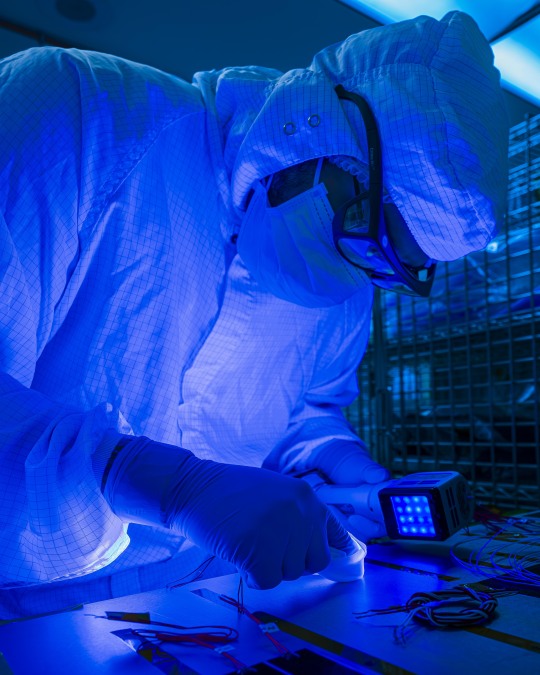
A technician analyzes a sample under ultraviolet light.
In addition, anyone who enters must wear a “bunny suit” to keep their body particles away from the machinery. A bunny suit covers most of the person inside. Sometimes scientists have trouble recognizing each other while in the suits, but they do get to know each other’s mannerisms very well.

This illustration depicts the anatomy of a bunny suit, which covers clean room technicians from head to toe to protect sensitive technology.
The bunny suit is only the beginning: before putting it on, team members undergo a preparation routine involving a hairnet and an air shower. Fun fact – you’re not allowed to wear products like perfume, lotion, or deodorant. Even odors can transfer easily!
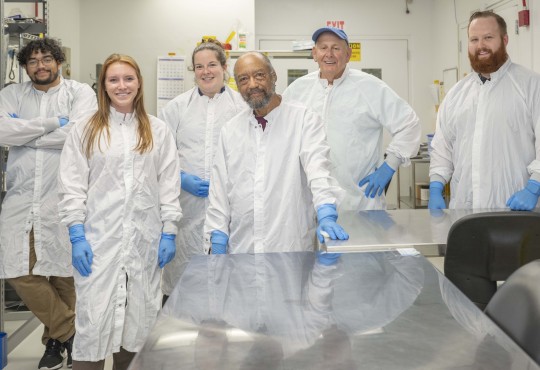
Six of Goddard’s clean room technicians (left to right: Daniel DaCosta, Jill Bender, Anne Martino, Leon Bailey, Frank D’Annunzio, and Josh Thomas).
It takes a lot of specialists to run Goddard’s clean room. There are 10 people on the Contamination Control Technician Team, 30 people on the Clean Room Engineering Team to cover all Goddard missions, and another 10 people on the Facilities Team to monitor the clean room itself. They check on its temperature, humidity, and particle counts.

A technician rinses critical hardware with isopropyl alcohol and separates the particulate and isopropyl alcohol to leave the particles on a membrane for microscopic analysis.
Besides the standard mopping and vacuuming, the team uses tools such as isopropyl alcohol, acetone, wipes, swabs, white light, and ultraviolet light. Plus, they have a particle monitor that uses a laser to measure air particle count and size.
The team keeping the clean room spotless plays an integral role in the success of NASA’s missions. So, the next time you have to clean your bedroom, consider yourself lucky that the stakes aren’t so high!
Make sure to follow us on Tumblr for your regular dose of space!
2K notes
·
View notes
Text
Mariner program
The Mariner program was conducted by the American space agency NASA to explore other planets. Between 1962 and late 1973, NASA's Jet Propulsion Laboratory (JPL) designed and built 10 robotic interplanetary probes named Mariner to explore the inner Solar System - visiting the planets Venus, Mars and Mercury for the first time, and returning to Venus and Mars for additional close observations.

The program included a number of interplanetary firsts, including the first planetary flyby, the planetary orbiter, and the first gravity assist maneuver. Of the 10 vehicles in the Mariner series, seven were successful, forming the starting point for many subsequent NASA/JPL space probe programs.
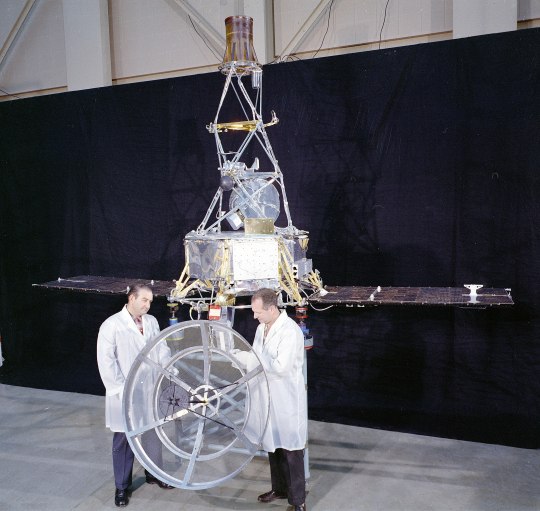
The name of the Mariner program was decided in "May 1960-at the suggestion of Edgar M. Cortright" to have the "planetary mission probes ... patterned after nautical terms, to convey 'the impression of travel to great distances and remote lands.'" That "decision was the basis for naming Mariner, Ranger, Surveyor, and Viking probes."

Each spacecraft was to carry solar panels that would be pointed toward the Sun and a dish antenna that would be pointed at Earth. Each would also carry a host of scientific instruments. Some of the instruments, such as cameras, would need to be pointed at the target body it was studying. Other instruments were non-directional and studied phenomena such as magnetic fields and charged particles. JPL engineers proposed to make the Mariners "three-axis-stabilized," meaning that unlike other space probes they would not spin.

Mariner 1 and Mariner 2
Mariner 1 and Mariner 2 were two deep-space probes making up NASA's Mariner-R project. The primary goal of the project was to develop and launch two spacecraft sequentially to the near vicinity of Venus, receive communications from the spacecraft and to perform radiometric temperature measurements of the planet. A secondary objective was to make interplanetary magnetic field and/or particle measurements on the way to, and in the vicinity of, Venus.

Animation of Mariner 2's trajectory from August 27, 1962, to December 31, 1962. Mariner 2 · Venus · Earth.
Mariners 3 and 4
Sisterships Mariner 3 and Mariner 4 were Mars flyby missions.
Mariner 3 was launched on November 5, 1964, but the shroud encasing the spacecraft atop its rocket failed to open properly and Mariner 3 did not get to Mars.
Mariner 4, launched on November 28, 1964, was the first successful flyby of the planet Mars and gave the first glimpse of Mars at close range
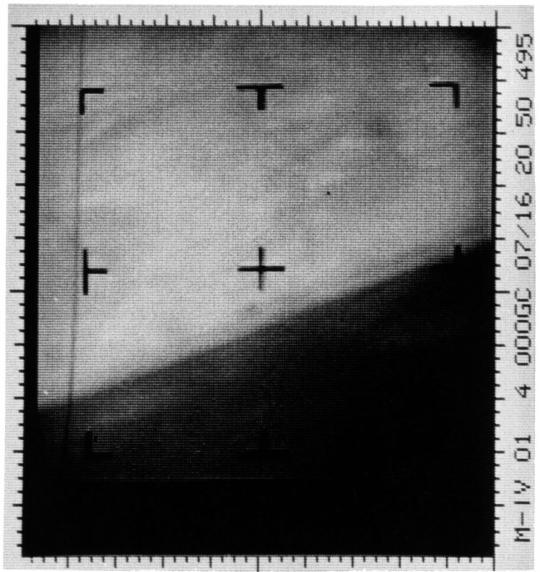
This archival image is an enhanced contrast version of the first Mars photograph released on July 15, 1965. This is man's first close-up photograph of another planet -- a photographic representation of digital data radioed from Mars by the Mariner 4 spacecraft. Data was either sent to Earth immediately for acquisition or stored on an onboard tape recorder for later transmission.
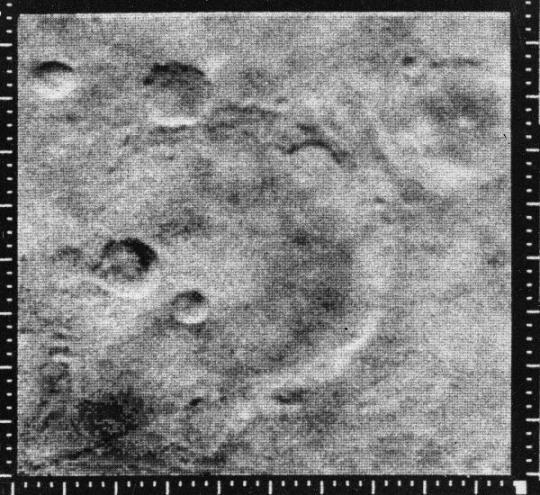
The pictures, played back from a small tape recorder over a long period, showed lunar-type impact craters (just beginning to be photographed at close range from the Moon), some of them touched with frost in the chill Martian evening.
Mariner 5
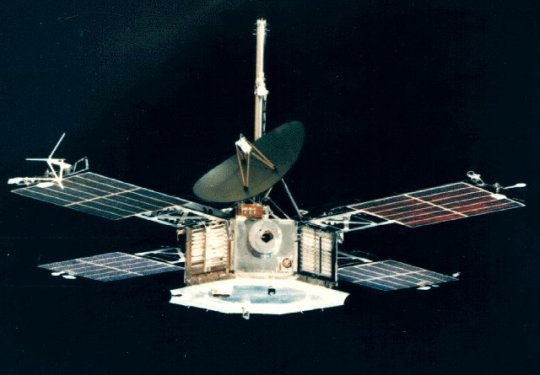
The Mariner 5 spacecraft was launched to Venus on June 14, 1967, and arrived in the vicinity of the planet in October 1967. It carried a complement of experiments to probe Venus' atmosphere with radio waves, scan its brightness in ultraviolet light, and sample the solar particles and magnetic field fluctuations above the planet.
Mariners 6 and 7
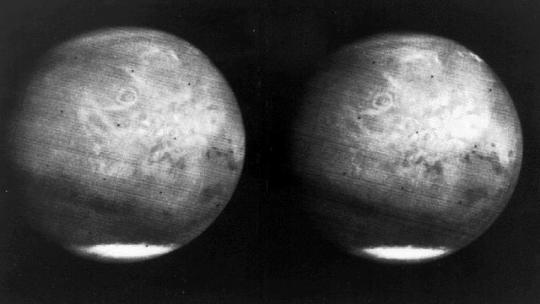
Mariners 6 and 7 were identical teammates in a two-spacecraft mission to Mars. Mariner 6 was launched on February 24, 1969, followed by Mariner 7 on March 21, 1969. They flew over the equator and southern hemisphere of the planet Mars.
Mariners 8 and 9
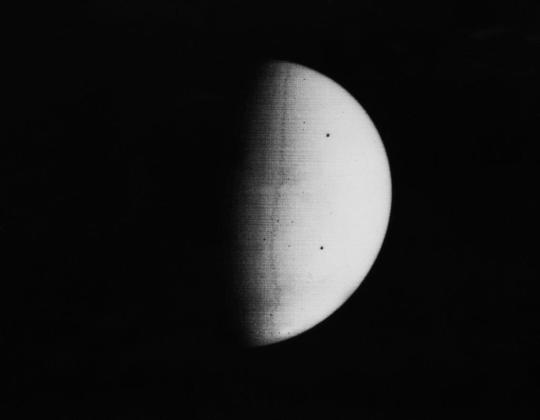
Mariner 8 and Mariner 9 were identical sister craft designed to map the Martian surface simultaneously, but Mariner 8 was lost in a launch vehicle failure. Mariner 9 was launched in May 1971 and became the first artificial satellite of Mars.
Mariner 10

The Mariner 10 spacecraft launched on November 3, 1973, and was the first to use a gravity assist trajectory, accelerating as it entered the gravitational influence of Venus, then being flung by the planet's gravity onto a slightly different course to reach Mercury. It was also the first spacecraft to encounter two planets at close range, and for 33 years the only spacecraft to photograph Mercury in closeup.

Venus in real colors, processed from clear and blue filtered Mariner 10 images

Mariner 10's photograph of Venus in ultraviolet light (photo color-enhanced to simulate Venus's natural color as the human eye would see it)

This mosaic shows the planet Mercury as seen by Mariner 10 as it sped away from the planet on March 29, 1974.
source x, x | images x
#mercurio#mercury#venus#mars#marte#astronomy#astronomia#space#solarsystem#sistemasolar#universe#universo#mariner#mission#space exploration
250 notes
·
View notes
Text
Serving up the tiniest cuteness 🥰
Zooplankton can be subdivided into two major groups. Holoplankton (copepods and krill) spend their entire lives as plankton and thus provide major food sources for pelagic fisheries. Meroplankton (larvae of animals like barnacles, mussels, annelids, and fish) spend only part of their lives as plankton.
Copepods like the one in this video can be found in massive numbers across the world ocean. They play an important role in ocean food webs as predators—they eat even smaller diatoms and phytoplankton—and prey on animals like jellies, fish, and filter feeders.
Zooplankton are notoriously difficult to sample. Despite opportunities for mixing, individual zooplankton are tiny, and species are often patchily distributed. Coastal oceans are physically dynamic, high-energy environments. Winds, currents, and upwelling fronts affect the availability of nutrients and distribution of food that control zooplankton growth and dispersal. To tackle these challenges, the MBARI team developed the SIMZ program to explore more efficient zooplankton sampling and identification methods.
Traditionally, tow-nets are used to sample plankton along paths through the water. Because these paths often cross smaller environmental patches, they frequently lack the precision to associate zooplankton species' distribution and abundance with particular physical and biological processes. MBARI engineers have equipped an autonomous underwater vehicle (AUV) with gulpers—bottles that rapidly inhale discrete water samples—to better understand the spatial patchiness in zooplankton abundance. The AUV is equipped with sensors that measure things like temperature and salinity, and onboard computer software that instructs the Gulper AUV to recognize and autonomously sample specific environmental patches, such as upwelling fronts or chlorophyll layers. This "surgical" approach to ocean sampling allows SIMZ researchers to study the effects of specific physical processes on zooplankton distribution and diversity.
105 notes
·
View notes
Text
Citizen Science and Contributing To Scientific Endeavor When You're Not "A Scientist"
Comments on some of my posts about science and misinformation express frustration with scientific establishments, and want to see more accessibility and attention given to amateurs participating in the scientific process and having their scientific voices heard.
If being involved in the creation of knowledge and discovery is something important to you, that's something I strongly encourage! It's absolutely possible. Amateur researchers with a passion and an eye for detail have made some fantastic discoveries - but what is often glossed over in stories like these are the years of work, the patient dedication, and the collaboration with university researchers that often underlie such discoveries.
The search for truth and information and the passion for science is present in a lot of people who aren't official "scientists" - curiosity is natural! And if participation in scientific observation, hypothesizing, experimentation, and discovering new things about the world is important to you, there are lots of ways to go about contributing - and the new year is a great time to start.
What are you interested in?
Ecology
Observing the world around you is for everybody. Getting invested in the environment of your hometown is for everybody. And, as the Mythbusters famously said,
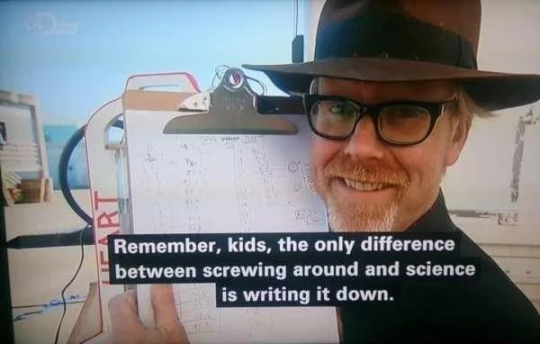
Some ideas for a local ecology project:
Record the temperature outside every day at the same time - at sunrise, or noon, or sunset, or midnight. Depending on where you are, the local weather recording station may be miles away or on top of a mountain - measure the temperature yourself and compare it each day to what your app says. When is it accurate? When isn't it?
Record the weather every day. How much precipitation? What time of day? What kind?
Record what animals you see every day, where, when, and how many. Or choose a specific animal, like birds, or bees on flowers, or turtles or frogs in a local pond, or whiptail lizards vs. invasive house geckos, and record the numbers you see each day.
Record when in the year you see the first, or last, of a plant or animal. When the crocuses sprout, when the buds appear on the maple trees, when you see the first clover flowers or prickly pear flowers, when the first robin comes out or the first lizards come out of hibernation.
If you have an outdoor cat or a free-roaming dog, attach a GoPro or similar small camera to its collar to see where it goes and what it does.
Identify the plants growing in your neighborhood, and check in on it regularly to keep track of how each one fares in different weather conditions, or if any animals particularly like or don't like to eat it.
Bulk order some test strips, then take a small sample of soil from a local park or water from a local waterway each weekend and test them for PH, lead, chemicals, or whatever. See if it changes over the year, or after a heavy rainfall, or during drought.
Take a photo of the same spot every day for a year.
Linguistics
The study of how people use language! Everybody uses language in some capacity.
Do you have any small children near you? Talk to them! Record how they pronounce things and what they call new (or even familiar) concepts. Look for patterns.
Ask people you know if "dog" and "blog" rhyme, or if "Alohop" is a good pun for a pineapple beer. My family gets ENDLESS amounts of mileage out of this one with each other. Ask people you know questions about how they pronounce things, or what they call things. Make maps of dialectical differences between generations, neighborhoods, etc. Track linguistic shifts in the modern world.
History
Everyone and everywhere has a history, and accurate history is pressingly relevant always.
See if you have a local historical society, library archive, or history museum that is looking for volunteers to transcribe or translate collections.
Get elbow-deep in local archives. You likely have some sort of local archive near you that has not been fully digitized. Go in with a topic you want to learn about - Black families, Jewish communities, how your hometown transferred from Indigenous hands to settler ones, women who owned their own businesses, immigration, inter-racial relationships, sports, ice harvesting, farming practices, contemporary opinions on a major world history event that now seems so inevitable, sports and people's reactions to sports - and read everything in newspapers, wills, deeds, photographs, or other available records about your topic of choice. See if you can find connections that you haven't seen anyone else talking about.
These are just some things that occur to me immediately as something that anyone can do, if you're sufficiently interested in a question and want to discover more about it. The more local your topic, the less likely anyone has a solid answer to whatever you're wondering - and the more immediately relevant to the people around you your discoveries may be!
Combining it with a New Year's Resolution can also get you more motivated to do the things you want to do. Is your resolution to get more exercise? Take a brisk walk each morning and take a picture of the same area every day for a year. Take a walk every weekend down to the lake and count the turtles and frogs you see. Is your resolution to keep a daily diary For Real This Time? If nothing else, resolve to write down the weather and precipitation each day! Do you want to volunteer more or meet new people? Look for citizen science or local history groups! Feeling like you're working toward something Real is a great motivator.
Henry David Thoreau's detailed descriptions of the nature each day around Walden Pond in the 1840s provides a valuable benchmark for modern ecologists to compare environmental and climatic changes since then on a granular level. Silly rhyming poems and idiosyncratic spellings in letters and diaries help linguists track dialectical and pronunciation changes across time. Amateur science is great and valuable! We all can have a part in understanding and paying deeper attention to the world around us, if we want to.
#been sitting on this one for a while ever since I kept getting comments on my post about misinformation about how scientists are all#ivory tower eggheads who don't allow real normal people to Contribute to Science#Please contribute to science! I think everyone who wants to should!!!#science#citizen science
301 notes
·
View notes
Text
Tutcetus: Dwarf Basilosaurid
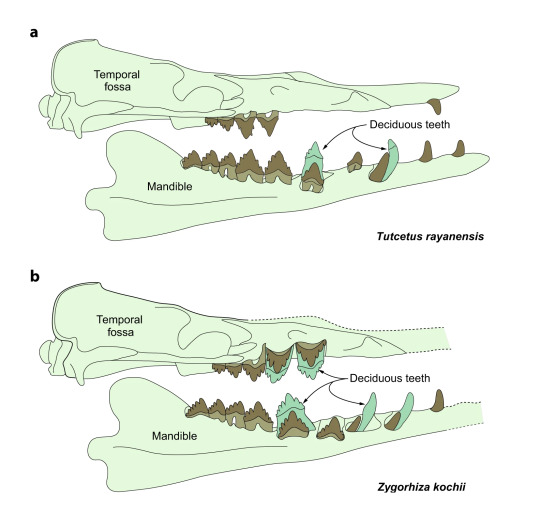

It's funny, barely a week after the reveal of Perucetus, perhaps the largest known basilosaurid so far, we immediately see the description of what may be the smallest.
Tutcetus, named after child king Tutankhamun, is a new species of early whale that may have measured only 2.5 meters. Known from a single skull of what is thought to be a subadult at the very edge of maturity, it is also one of the oldest basilosaurids. The fossil was discovered in the famous Fayum Depression, i.e. one of the most important regions for early whale fossils.
While its generally hard to tell age, the stage of tooth replacement and the fusion of the skull bones indicate that Tutcetus was about to reach maturity, so it likely didn't grow much larger than indicated by the holotype fossil.
Tutcetus seems to be an early diverging basilosaurid (which is paraphyletic according to the authors), with its closest relatives being Ocucajea (a contemporary of Perucetus) and Chrysocetus.
Although our sample size is obviously low, the authors still tried their best to deduce some parts of its biology. For instance, they suggest that the small size of this animal might be related to the warmer temperatures of its time and that Tutcetus followed the mantra of "live fast, die young". They argue that Tutcetus, again based on how its teeth were replaced, matured quickly to reproduce sooner, while never reaching an especially old age. This would contrast later basilosaurids, which would grow slower, reach larger sizes and live longer. But of course more material would go a long way to confirm these suggestions.
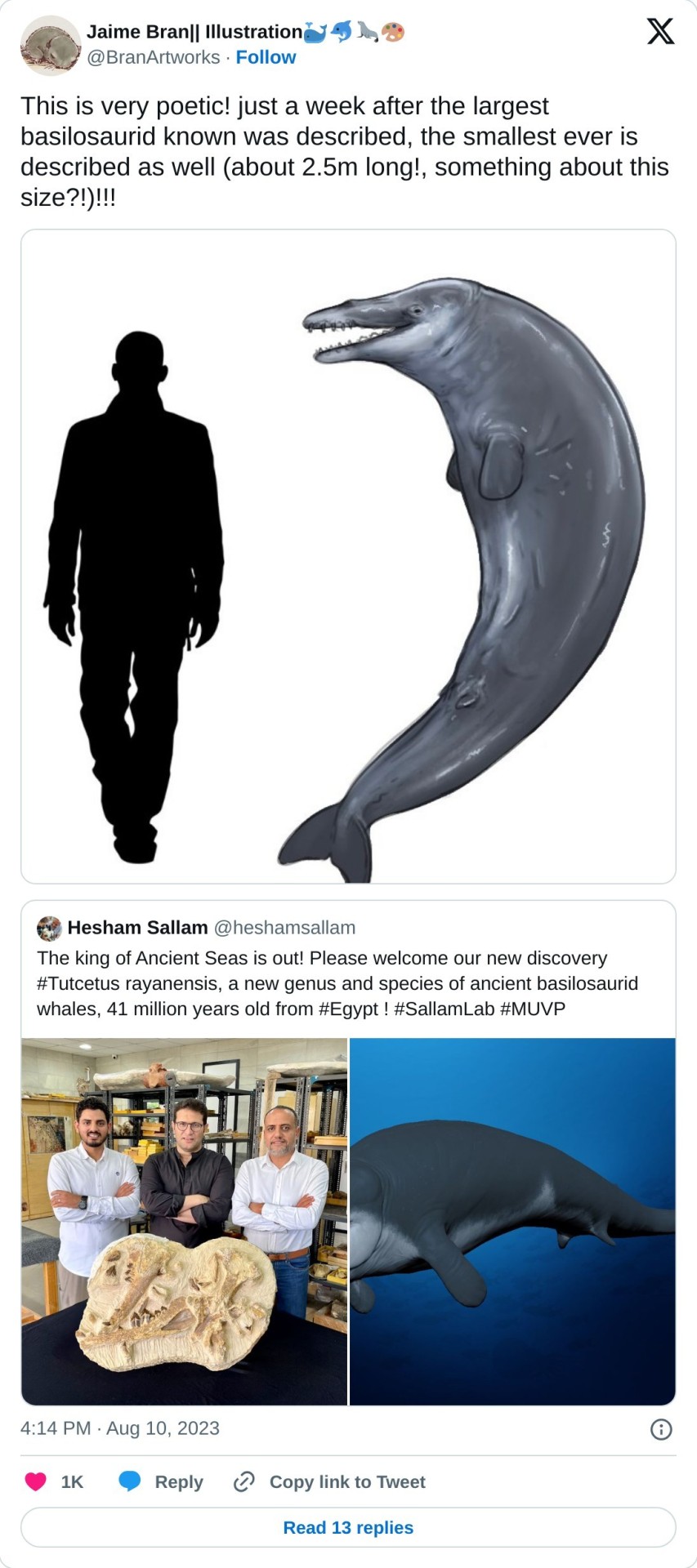
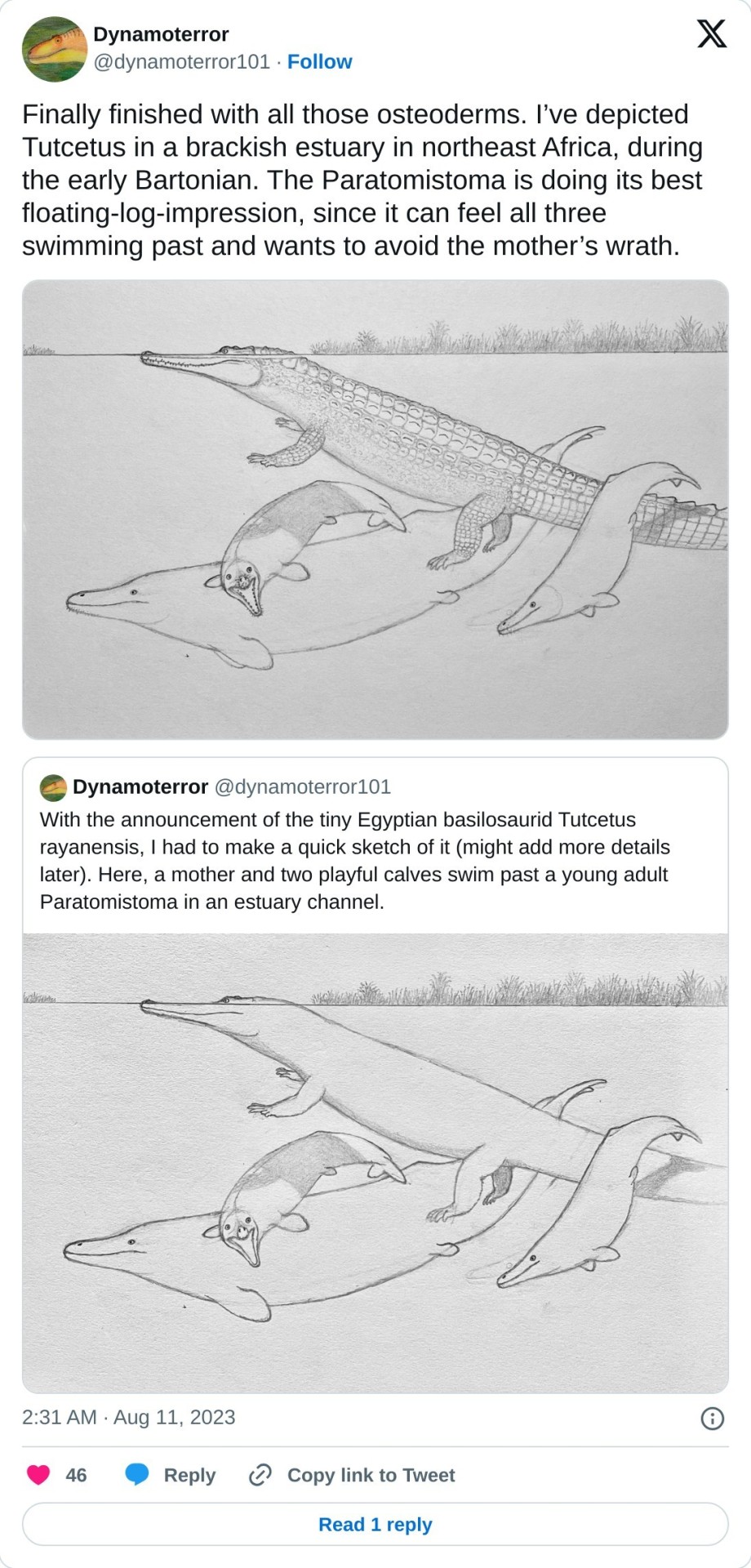
#palaeoblr#paleontology#basilosauridae#whale#cetacean#tutcetus#early whale#evolution#prehistory#eocene#egypt#fossil
587 notes
·
View notes
Text
senku when you're sick

- LMAO
- YOU IDIOT
- he definitely gonna make fun of you
- you'll be sniffling, sneezing, coughing, suffering in your bed when he gets home and he'll start laughing at you on the spot, lovingly of course
"...Senkuuu..." You dared to utter another word, or else a coughing fit will start to erupt. He walks up to the side of your bed after hanging his lab coat and setting down his gear, covering up his smile with his hand.
"Pfft, are you serious, y/n?" He failed to hide the laugh that escaped going forward. "You weren't like this yesterday, with all that 'Oh no, Senku! I'm not gonna get sick if I go outside in the rain, in summer wear, and measure acidity levels! I'm practically immune to this weather!-" He palmed his head as his laughter let loose from the strain.
"Shut up! It wasn't supposed to happen like this! I.." You stopped and quickly stuffed your face into your arm as violent coughs began to force out.
"Like what..? You laid in bed all day all icky?" He retorted, taking a seat on the bed. He leaned closer to you and pushed back the hair in your face before resting the back of his hand against your forehead, feeling your warm temperature. He concluded with a hypothesis of what you had, judging by your temperature and symptoms. He looked down at your vulnerable form and sighed.
"...you're one stupid girl, you know that?" He remarked as you rolled your eyes in ignorance. He leaned down again and tucked your loose strands of hair behind your ear. Your cheeks burned from the small action. "...but, you're my stupid girl, so I guess you deserve a bit of leniency."
- damn i just reread that and it got me kicking my feet giggling and shit but anyways 💀
- don't you worry one bit, senku will have you taken care of after clowning you, starting in the kitchen with an apron tied on
- he'll cook you up a nice pot of chicken noodle soup, vegetables added for nutrients
- he'll make you a steamy cup of chamomile tea with lemon and honey, of course, the amount adjusted to your likeness of sweet or lemony
- he knows liquids are very important, so expect more room temperature juices and hot teas of the such from him
- he'll also gather all the supplies of tissue and cough medicine in the house and have it set up on the nightstand on your bedside
- if you run out of tissue, he'll bring you a roll of toilet paper bc they're basically the same thing, and you'll start laughing for no reason 💀
- after every cup of tea or bowl of soup, you compliment his culinary skills, and in some cases, you thank him dearly, to which he scoffs and rolls his eyes in response
- but in reality, it makes his heart beat a lil faster, makes him smile
- if your illness is way out of what he expected, he'll go out of his way to diagnose you, taking a small sample from you and checking the bacteria for himself under a microscope
- he'll do anything for you in order for your health to get back up to par
- except maybe one thing
"But Senkuuu I don't like that medicine..." you complained, eyeing the tiny cup of thick dark blue that he poured for you to take earlier. "It's gross...like drinking liquid metal chemicals."
"Y/n you're acting like a child. Of course, it's going to taste like that, it's medicine. Now, go ahead and take it already." He turned around to exit the room, but he was struck behind by the pillow you'd thrown.
"...I'll only take it if you give it to me." He turned around and stared at you. You stared right back at his crimson-red eyes as you crossed your arms. A long, heavy sigh escaped from his mouth as he picked up your pillow and made his way over to your side of the bed.
"Fine. But only because this medicine is really for your own good. It's important you take."
"Yeah, yeah, okay." You sat up while he first stuffed the thrown pillow behind your back. He picked up the cup with his fingers while the other hand cupped your cheek, his thumb resting just above your chin and under your bottom lip. Before he began the action, you stopped him mid track. "No I...I want you to give it to me from..." Your hand motions finished your words. Your thumb brushed over lips in a coy manner, but Senku could read in between the lines.
"Ew," he muttered stonely. "Why the hell would do something like that?" Rhetorical question, y/n.
"...it'd taste sweeter coming from your lips." You wiggled your eyebrows teasingly.
"..." He sighed once more, pinching his nose bridge. "...If you wanted to kiss me that badly, you should've said so in the first place," he chuckled, a smirk beginning to form. "You know I give what you ask for, y/n...Now, close your eyes." He ordered before filling his mouth with the medicine from the tiny cup. He leaned down, cupping your face and brushing his lips against yours, allowing you to part them a little. Then, his landed on yours, followed by the liquid slowly dripping down your throat. You quickly swallowed to capture his lips in an embrace, savoring the warmth you shared.
- 😍
- PLEASEPLEASEPLEASEPLEASE

support me? :)
#senku x reader#senku ishigami x reader#ishigami senku x reader#senku x y/n#senku ishigami x y/n#dr stone x reader#drabbles#chrome x reader#gen x reader#gen asagiri x reader#senku#senku ishigami#dr stone#x reader#senku imagine#senku headcanons#w.midizu
633 notes
·
View notes
Text

Ultra-sensitive photothermal microscopy technique detects single nanoparticles as small as 5 nm
The detection of individual particles and molecules has opened new horizons in analytical chemistry, cellular imaging, nanomaterials, and biomedical diagnostics. Traditional single-molecule detection methods rely heavily on fluorescence techniques, which require labeling of the target molecules.
In contrast, photothermal microscopy has emerged as a promising label-free, non-invasive imaging technique. This method measures localized variations in the refractive index of a sample's surroundings, resulting from light absorption by sample components, which induces temperature changes in the surrounding region. Whispering gallery mode (WGM) resonators are ultra-sensitive temperature sensors due to their ultra-high quality (Q) factors.
Read more.
14 notes
·
View notes
Text
Have you ever wondered how scientists know what earth's climate was like in the past? Thousands of years ago, long before humans started to measure and record these things?
It's a really fascinating question with a VERY cool answer! Ice cores! Basically, they go to someplace cold, like the Arctic or Antarctic, and drill really deep into the ice to take a vertical section of it.
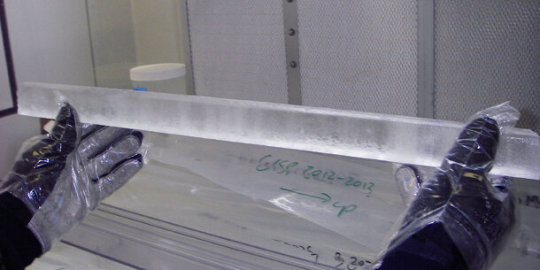
[ID:A cylinder of ice, about an inch in diameter and perhaps a little over a foot long (that's around 2.5 centimeters in diameter and over 30cm long, for those of you sensibly using the metric system), held in thickly-gloved hands. End ID.]
Here's what they look like. Kind of - they're a lot bigger when they come out of a glacier, but they get broken down into smaller pieces for transportation and study.
The US National Oceanic and Atmospheric Administration has a cool article on it here, but I'll go over the basics because tumblr science communication has a uniquely fun dialect, and I much prefer to learn things that way. I'm also putting it under a read-more because it got long.
If you've ever taken a geology class, you probably know that rock gets deposited vertically over time, with the newest at the top and the oldest at the bottom. In places where ice stays frozen for a long time, it's basically the same principle - year after year of snow and ice layered on top of each other. Ice cores can include stuff that's been frozen for perhaps thousands of years - including air bubbles, dust, sea salt, volcanic ash, etc. Both those and the ancient ice itself can tell us things about what earth's climate was like when they were first frozen.
The water in the ice cores contains, just like water from today, varying ratios of oxygen isotopes: oxygen-16 and oxygen-18. Remember, the difference between isotopes is the number of neutrons in each atom - oxygen-16, with 16 neutrons, is the 'normal' one, which makes up over 99% of oxygen atoms. It's also lighter than oxygen-18, which has two extra neutrons, and that means that it's slightly more difficult to get out of the atmosphere via precipitation - and this is easier at colder temperatures. So, as global climate gets cooler, the ratio of oxygen-16 to 18 increases, and as global climate cools, it decreases. We can measure those ratios in ice cores to figure out what Earth's climate was like in the past - as far back as we can find ice. How far is that? Up to 800,000 years. Yeah, that's some fucking old ice.
That's a lot of ice, I can hear you thinking. You're right - the deepest ice core ever collected was 3769m - 3.7 kilometers of ice (for my fellow Americans, that's over 2 and a quarter miles). That is a stupidly long piece of ice. Now you know why they have to break it up to analyze it.
Also, remember those air bubbles I mentioned? We can measure the concentrations of gases in those to learn about the composition of Earth's atmosphere a long fucking time ago, including the concentration of greenhouse gases like carbon dioxide and methane. (How do you get air bubbles out of ancient ice you ask? NOAA has the answer: crush it under a vacuum hood. That means there's no other gases around to contaminate your sample while you put it in an airtight vial.)
How do we know how old the ice is? Same way we date other ancient stuff - there's two main methods.
Radioactivity and radioisotopes! Mostly naturally occurring, although for recent ice, radioactivity from nuclear testing can also be used. Carbon dioxide can be radiocarbon dated, volcanic material can be argon/argon dated, etc.
Layering! Especially looking for distinctive stuff like volcanic ash from significant geological events. This can be used to synchronize ice cores from different places, or for relative ages (i.e. this section is older than this one).
These are far from the only things ice cores can teach us, but this post is already very long so I'll leave it here. Check out the NOAA article for more details, and a fun anecdote about how no fieldwork project ever goes entirely according to plan - especially when there's polar bears.
Sources: 1, 2
#hylian rambles#hylian does science#science side of tumblr#climate change#ice cores#science education#i should do a followup post about the history of atmospheric greenhouse gases sometime#dig into some actual ice core data. because it blew my mind when i first saw it and i'm sure it'll blow yours too.
11 notes
·
View notes
Text

European X-ray laser explores a poorly understood state of matter
The properties of warm dense matter have until recently been little known. Now, thanks to the use of X-ray lasers, physicists are gaining more and more information about this important but still mysterious state of matter. The first comprehensive observations of ionisation processes in warm dense matter, carried out at the European X-ray Free-Electron Laser (European XFEL), have just been presented in one of the most prestigious physics journals.
State of matter with a temperature of a few thousand degrees and a high density, close to that of a solid, can be found, among others, in the interiors of brown dwarfs or gaseous planets. Although common in the Universe, it is very difficult to be produced and analysed in the laboratory. A new era in experimental research of this so-called warm dense matter (WDM) state began just a dozen years ago, when physicists launched the first free-electron X-ray lasers. At the forefront of this type of device is the nearly 3.5 km-long European XFEL laser. A series of experiments recently carried out there made it possible to observe for the first time how quickly a metal transforms into the exotic state of ionised WDM to become transparent (non-absorbing) to X-rays at the end of the process. The achievement of the international team of scientists – including those from the Institute of Nuclear Physics of the Polish Academy of Sciences (IFJ PAN) in Cracow – is discussed in a paper published in the journal Nature Physics.
X-Ray Free-Electron Lasers (XFELs) are used to generate high-intensity X-ray pulses lasting single femtoseconds, i.e. millionths of a billionth of a second. These can be used to study the structure of matter at atomic length scales and to track phenomena on extremely short time scales. One of only a dozen such devices in the world is the European XFEL in Hamburg, built in cooperation with the DESY research centre.
“In our experiment at the European XFEL, we illuminated copper samples with X-ray pulses lasting 15 femtoseconds, using different, gradually increasing intensities”, Prof. Beata Ziaja-Motyka (IFJ PAN, DESY) introduces the experiment. The first author of the paper in question, Dr. Laurent Mercadier from the European XFEL, adds some physical details: “When a single X-ray laser pulse reached the material, it caused strong ionisation. The electrons released in the process were characterised by high temperatures. Under these extreme conditions, the copper was transformed into a state of warm dense matter. We meticulously recorded how much radiation passed through the matter and from this inferred the ionisation changes in the observed system.”
Simulations carried out using the BOLTZMANN SOLVER software, developed since 2004 at DESY by Prof. Ziaja-Motyka, were particularly helpful in interpreting the measurement results. This tool was used to simulate changes in the electronic occupancy of individual energy levels in WDM depending on the intensity of the incident laser radiation.
By confronting experimental data with simulations, it was established that when the X-ray intensity becomes sufficiently high, atoms of WDM become strongly ionised. As a result of this phenomenon, new energy levels appear which can be occupied by excited electrons – making WDM opaque for photons resonant with transitions to these new energy levels. These states had already been observed previously with optical lasers, however, the lasers’ energy limitations did not allow them to be studied in more detail. Now, thanks to the European X-ray laser XFEL, it is possible to characterise them accurately also in response to various intensities of X-ray pulses. In accordance with theoretical predictions for X-ray absorption spectra, prepared by Dr. Joshua Kas (University of Washington, USA) and Dr. Andrei Benediktovitch (DESY, Hamburg), it was further observed that with increasing the laser intensity the warm dense matter becomes first opaque and then – at highest intensities – transparent to the laser pulse.
“The appearance of ‘transparency’ – i.e. lack of absorption – in WDM is a consequence of the high ionisation of WDM atoms occurring at sufficiently high X-ray pulse intensities. The energy of the X-ray photons available in the experiment then becomes too small to excite further electrons. As a result, these photons cannot be absorbed by the warm dense matter at all,” explains Prof. Ziaja-Motyka.
Knowledge of the properties of warm dense matter and the processes taking place within it is not only of astrophysical, but also of practical, engineering importance. Matter in this state plays an important role in certain types of controlled nuclear fusion (ICF – Inertial Confinement Fusion), and also appears during the ablation of metallic heat shields of spacecraft returning from orbit to Earth.
The team of physicists at the European X-ray XFEL laser, led by Prof. Nina Rohringer (DESY, Universität Hamburg), intends to continue research into the electron and ionisation processes occurring in WDM and their dynamics. On the Polish side, the work is co-financed by the Institute of Nuclear Physics of the Polish Academy of Sciences.
IMAGE: Warm dense matter occurs inside Jupiter-type giant planets (where it surrounds the rocky core as a metallic liquid at a temperature of many thousands of kelvin) and in the interiors of small stars – brown dwarfs. Credit Source: IFJ PAN / NASA
#science#space#astronomy#physics#news#nasa#astrophysics#esa#spacetimewithstuartgary#starstuff#spacetime
7 notes
·
View notes
Text
trying to get screened for diabetes today
arrive at pharmacy for the test. i've been screened at the same pharmacy before so as they're setting up increasingly i'm like hmm this seems like a more intensive blood test than what i had last time
'hey is this the test where you get the results same day' nooo this is the 48 hour test
im a dumbass who booked the wrong test. good news is i can do the correct test today!!
bad news is for reasons i don't understand the glucose measuring machine for the other test is stored in the fridge and has to be brought up to room temperature. normally they'd do that first thing but as they weren't expecting to use it today its still in the fridge.
told to come back in half an hour. live close by so just go home and kill time.
come back. they take blood from my left hand. put it in the machine. OOPS it's still too cold.
i can come back in half an hour OR reschedule for Monday. suggest coming back in an hour but the pharmacy closes at lunch time on saturdays & they get very busy in the last hour so no can do.
go to the supermarket. kill another 30 minutes. go back for attempt 2.
the machine is now too warm.
are u shitting me lmao
she put it in her pocket to try and bring it up to room temperature faster but overdid it and now it won't work
put the glucose meter back in the fridge
it now seems to be working. take blood from my right hand. wait 5 anxious minutes
machine says there's not enough hemoglobin in my blood. we will have to try again.
ask if i can have another plaster bcos i'm bleeding through the first one. 'oh you're still bleeding?' yeah is that good 'oh yes it means i don't have to stick you again'
take another blood sample w visible difficulty. put that in the machine
should i be worried about the hemoglobin thing?? (im in there bcos not feeling well so u know could be a blood thing)
oh no that's probably just bcos she didn't get enough blood (oops)
continue waiting for the remainder of the 5 minutes. it works this time.
anyway i don't have diabetes.
96 notes
·
View notes
Text
Arthur Kirkland's Famous Biscuits
AO3: Please give it some love :D
Words: 652
Prompt: "Arthur’s trying to get better at cooking and is having a cozy night in with Alfred, who helps him through making the recipe."
Made as a swap with @sarahhav on discord (their DELICIOUS Cardverse fic here)

Arthur fiddles with the oven temperature dial, tone dubious as his eyes scan the recipe. “Well the instructions are only recommendations, so-”
“Wha- No!” Alfred cries, not relaxing until Arthur has set the correct temperature. “Not for you.” Arthur frowns, staring down his nose and Alfred holds up his hands to profess innocent intentions. “C’mon, babe. I ain't Julia Child, but you asked me to help and I’m telling ya- Just follow the instructions exactly, step-by-step, and it’ll be impossible to mess up!”
England deflates a smidgen. This is Arthur’s third attempt today at baking, and his kitchen counters are littered with biscuits blackened on the outside and raw on the inside.
When Alfred, held up the office, opened their scheduled Zoom he witnessed an expression of violent self-contempt partially concealed by messy, sweaty bangs. Those eyebrows intensified any facial emotion so that Alfred was momentarily concerned someone had died. England working an oven wasn’t any less worrying, though.
“Fine, we’ll try your uncreative approach. And don’t cut me off!”
America watches through the slightly smudged lens of England’s tablet camera as he meticulously measures butter, flour, and sugar on a tiny scale. America demands to be brought closer to confirm his partner is subtracting the bowl weight, and double checks the grams and pre-heated oven temperature. America watches England combine the ingredients in a porcelain bowl, watches him cover the bowl and place it into the fridge to chill.
Together they watch the latest Doctor Who.
Then America, now from the comfort of his couch and nibbling on discounted supermarket sushi, watches England roll the dough out until he can cookie cut twelve three millimeter thick disks.
America watches England gently, reverently, anxiously place the disks on a lined baking sheet and slide it into the oven. England spends the next eleven minutes defending the modern practicality of sock garters and America doesn’t quite admit he’s lost but his silence is enough of a victory that England isn’t devastated when he opens the oven and has his face assaulted by a blast of bitter smoke.
England grabs his oven mitt and places the smoldering sheet on the stovetop. America watches silently with wonder on his face and impossible questions scrambling for room on his tongue. His eyes are wide and England snorts deprecatingly when he hears Alfred’s wooden chopstick fall to the floor on the other side of the world.
“I don’t- how? How!? You followed the instructions exactly-”
England bites gingerly into one of the biscuits, not really listening to America losing his mind behind him. The taste is a little burnt and his jaw struggles slightly breaking it. His eyes widen and a contented smile breaks his face, taking another bite.
These biscuits are delicious!
“Babe, Artie, non, I’m sorry but I think you’re cursed or something cuz those indigestion cookies-things should not be on fire!”
“Oh hush. You never can see past appearances,” Arthur hums, polishing off another biscuit to America’s abject horror. “They’re splendid!”
“Well,” America starts awkwardly, bending out of frame to find his chopsticks. He rubs them off on his pants and resumes eating his own food. “If you’re happy I-uh! I guess it’s a success! Glad I could help!” His tone would sound insecure to anyone whose name wasn’t Arthur Kirkland.
Arthur Kirkland thoughtfully arranges the remaining cookies on a plate. “If only you were here to sample these,” says Arthur, tone rife with genuine longing. “Then you could give me something in return.” Arthur turns to face the camera and Alfred melts at the horny, yet tender expression he wears.
“What wouldn’t I give to try those?” Alfred asks rhetorically, pushing aside the finished plate and balancing his head on one wrist.
“Well, thanks for your help, luv. I'd better head to the office, sleep well and we'll talk Friday.”
“Love ya,” Alfred gets in a kissy noise before Arthur ends the call.
17 notes
·
View notes
Text
Sampling Error
Ectoberhaunt 2023 Day 4: Aliens
AO3 Link
Summary: You should always be careful where you gather your data because you can always end up with a bunch of outliers. Or Danny ends up abducted by aliens.
Warnings: abduction, kidnapping
Words: 1812
They had found this particular specimen sleeping on the top of one of the structures built by the native inhabitants of this planet. From preliminary research on the native species, this particular kind was sapient and rapidly developing, locally known as ‘humans’, likely to join the cosmos within the next millennia. The one they had sedated for inspection was an adolescent male. The intention was to observe the specimen and take base vitals, before another round of sedation upon release. With a bit of luck, he wouldn’t remember anything, other than some possibly subconscious trauma. An unfortunate, if slightly helpful effect of his capture.
It was exciting to be dealing with a live specimen, since all of their past research had been either from a distance, or gathered digitally through the planet's local information networks. Luckily, there was plenty of it currently, but there were still some gaps that they needed a live specimen to gather. Mostly just to fill in the places in their report that the “humans” hadn’t yet discovered, and to verify the collected data. Their guest was currently unconscious in a sterile room, designed to be a familiar and comforting place, where resting vitals were being measured from a distance through the specialty biometrics scanners. They just wanted to see if those vitals matched up with the information they had gathered before he woke up.
Already, there were alarms and concerns being pinged. Their subject had no heart rate, his internal core temperature was desperately low, and he wasn’t breathing in the simulated atmosphere in the containment room. Panic broke out in the observation room.
“Why is he dead?” One of the researchers exclaimed.
“The atmospheric composition, temperature, humidity, and gravity are all fine! Maybe we grabbed a deceased specimen?”
“There aren’t any visible injuries! Did we get the dose of the sedative wrong?”
“Maybe? Humans are fragile! It was probably an internal issue, nothing that was our fault. Let’s do some deeper anatomical scans.”
There was the slight humming of machinery as internal scans were taken.
“That… looks a bit different than the local research.”
“How did he manage to get whole stones in his liver?”
“Yeah… that’s weird, but more importantly what is that organ fused with his heart? The scanners won’t give me much information about it, it’s giving off interference.”
“Biological, carbon-based beings don’t give off interference. The scan’s just malfunctioning. Do it again.”
There was a pause, and the “broken” scans got passed around, while a new one was being taken.
“Same result,” the researcher groaned. “And there’s nothing wrong with the scanner. I’ve already run diagnostics on it too.”
In the containment room, the human groaned and blinked awake, vitals returning, breaking the argument as the sensors screamed to life with the sudden shift in vitals, now active but still far too low. The room fell silent as a pair of bright blue eyes seemed to stare directly at the group of scientists.
“He’s awake,” someone stated the obvious.
“He really shouldn’t be, since he’s dead.”
“Well, his vitals have returned… though they still don’t match the pre-gathered baselines after that initial spike… Did we mix up the conversions from Earth measurements to galactic standard?”
“No, we’ve checked this math a jahrdec’s worth before converting our numbers over. Our numbers are fine. Maybe this specimen is just an outlier?”
“It’s possible. That would be some luck if he is.”
“We should probably get some answers if he’s willing to communicate. It might be best to just collect some case file information, and grab a different one later.”
“Irritating… but your point is understood. Is the communication translator working up to standard?”
“It… should be. There’s likely still a few language glitches. But it works as intended.”
“Then I suppose let’s initiate ‘prime introduction’.”
Danny had been having a bit of an off day. He had a test this morning that he had actually managed to go to, only to struggle through the entire thing, and barely finish it within the allotted time. Then Skulker had decided to visit for a lunchtime hunt. Then there had been a blob ghost infestation in the Neon District after school, so he had to draw the ghost hunters away from there while Sam and Tucker gathered the blobs and returned them to the Zone. That was pretty tiring too. Then Johnny 13 had decided to drag race through town against Technus, and that was the opposite of fun, especially when Technus hit him with that stupid electric car Vlad had bought recently (no regrets about leaving a dent in the hood though).
So, Danny was tired, and his parents weren’t likely to find him taking a nap on the top of the downtown office building. So, he couldn’t really be faulted for “sleeping like the dead” when he finally stopped to rest. But of course, with enough panicked shouting, even the dead will awaken, especially in Amity Park. So when Danny woke up to a bunch of bickering in a language he didn’t understand, it took him a second to gain his bearings.
At first, the blinding panic that overcame Danny was enough to spike his vitals up to almost-human levels, whiplashing his insides out of their nap-time pause. He thought, just for a moment, that he had been taken to either a morgue or a lab. But then Danny realized that 1) he wasn’t naked, and 2) he wasn’t strapped down. Also, he didn’t think either of those used a light yellow, floral wallpaper or lighting that looked like it was kidnapped from a thrift store.
It was all a little bit uncanny, really, how the room had been set up, lacking both visible doors or vents, and fit too seamlessly together. There was no furniture in the room other than the thrift store lamps, and the table was covered with a thin blanket that he had been sleeping on. It smelt vaguely somewhere between hairspray and lemons, too clean. The only imperfections at all in the poorly decorated box he had been trapped in were small objects on the ceiling that could’ve been either sensors or cameras. He could pick up shouting from the other side of the two-way mirror poorly disguised as a normal mirror. He didn’t understand a word.
The chatter died down almost immediately after Danny had started staring at the window, trying to see if he could spot something on the other side.
There was a hum from… somewhere, and a voice echoed from overhead.
“Well dawn, why were you dead?”
The voice was artificial in the way syrups and flavorings were, but far better than any sort of voice changer or text-to-speech Danny had ever heard. Also, the phrasing was odd enough that Danny almost focused on ‘well dawn’, mouthing it under his breath before the question registered.
“That’s rude,” Danny retorted. There was a pause before the voice responded.
“Apologies. Your vitals were not applicable and we assumed you had died. Why?”
“Just sleeping like the dead. So, who kidnapped me this time?” Danny was pretty sure it wasn’t one of the cult or those ghost hunters. Like, 90% certain. Neither of them had this kind of aesthetic. Also neither of them talked like a broken thesaurus. He was definitely mentally writing down some of the phrases for later though.
“We identify as the boffins of the Galactic Organization of Lifeform investigation. What is your issue?”
Danny wasn’t sure if it was just the weird AI voice, but he really couldn’t tell if they were insulting him or genuinely asking. Also, he didn’t know what a ‘boffin’ was, so he was adding points to the likelihood of having been kidnapped by a really weird cult. The word ‘galactic’ stood out to Danny though. Galactic meant space, and the room he was in was pretty weird too… Danny really hoped couldn’t believe he had been kidnapped by aliens. So the running theory was still cult.
“Please respond to the before inquiry.”
Danny secretly added points to the category that now didn’t exist in his head.
“Last I checked, the issues I’ve got are a bit ghastly, but plenty of people suffer from sudden bouts of… expiration.”
“Is the substandard tempo a symptom of demise?”
“I would say so, yeah.”
Danny was still really caught up on the wording, but also, speaking of words, he still had an English paper to complete and he was getting ideas. He also only understood about 60% of what was being asked.
“Hey, can I go home now? I’ve got some more things to do that involve not being here,” Danny asked.
“Your location shall be reset upon accomplishment.”
Danny didn’t like the sound of that. He was going to leave anyway.
“Well, sorry to disappoint, but I’ve got to ghost you on your science project, so… later.”
Danny let intangibility wash over him, and found himself plummeting from low-orbit. Another point to the secret category. At least it was a good view before he tried to finish that paper again.
--
The researchers watched as the human boy went directly through the floor with little effort, still reeling over the last message.
“Apologizing for upset, I must die on your experiment. Time passes.”
They glanced over the case file that had pulled together with less answers than before. Humans were capable of reviving themselves upon death, and possibly even passing through solid matter. It… really didn’t add up. No current research indicated that was possible for biological organisms. It could overwrite hertons of research.
“Where do you think he went?”
“Maybe back to the rooftop?”
“After plummeting from low-orbit?”
“Maybe he can fly too?”
Questions buzzed and floated around the room about the newly discovered aspects of human nature. It sounded common too, from the responses they had received before the specimen had fled.
One researcher, who had been operating the translation device, a dedicated linguist, spoke up. “Hey, there might be an issue with the translator.”
That caused the observation room to go quiet.
“It’s not picking up the contextual or cultural use of phrases in a whole context, just the basic word meanings, direct translations only.”
It was still quiet as the recordings were replayed, this time without automated translation for the benefit of the group. With the spoken inflections, the issue was a lot clearer.
“So… that means we have no idea what he was saying in context?”
“Not really, no.”
There was a mix of muttering and grumbling in a variety of different languages throughout the room, mostly upset and irritated.
“Doesn’t change the fact he still went through the floor into low orbit,” someone added.
“And that he still definitely lacked vitals when we found him.”
“Yeah… I think we should just leave the humans alone for now.”
There was a general consensus of agreement.
Ectoberhaunt 2023 Master Post
#ectoberhaunt23#EH science#Day 4#Aliens#danny phantom#goodfish writes#dp fic#this was actually so fun to write#oh the joys of mixing a faulty translator with puns
35 notes
·
View notes
Note
how do the ros kiss?

🥺(😏)
+ where they like to kiss


Dante kisses like he’s burning and he wants to spread the flame. A mess of teeth and hands and slow drags of lips against lips, a fever of neediness. Like tomorrow won't come and now has a sliver of possibility of lasting forever. Dante has no preference over where's or how's as long as attraction consumes the moment—though, in a very unconscious way, he seems fixated on the curve where shoulder meets neck.

Lilith kisses with glossy lips. It's a deliberate and slow game for her— Lilith kisses with measured expertise, a push and pull between her and her partner, a declaration of passion and desire that transcends the physical barrier of lips and tongues. She especially enjoys pressing kisses against inner wrists, feeling the pulse skyrocket, and goosebumps overtake the flesh due to the temperature change. Lilith is adaptable, she likes to be the one giving pleasure and not the other way around. She loves affection in any way that her partner desires to give it.

Josh kisses like it's a dream he refuses to wake up from, like he wants to remember each moment in perfect detail. It's a dance that's a long time coming, full of romantic ideas of perfect butterflies, sunsets, and butterfly-filled stomachs. Waking up from that dream is just as strangely refreshing. A full-of-warmth wonder. Flawed in its nature— short clicking of teeth and pauses to laugh awkwardly. Josh feels just as awkward when he kisses his partner's forehead just the way he likes to, though that quickly melts to bliss if they return the gesture against his neck.

Villanelle kisses like it's an old, familiar routine, like she's done it a million times and expects to do it a million more. It's a thing she doesn't want to rush—she doesn't want it to end—Villanelle kisses like she's spellbound, savoring the moment, sampling the tastes of your mouth, nibbling your lips playfully. She loves giving and receiving kisses on the cheek, like wrapping a ribbon around an already beautiful gift.

Victor kisses like he's indulging in a forbidden and unexpected fruit, like it's mind-consuming and all-consuming, like he can't ever get enough. Greedy and scorching in nature, Victor kisses like it's a last chance and means to make it worth his time. Turning kissing into normalcy would reveal to Victor's partners that he secretly enjoys turning everything into a routine, that he always kisses their temple— and down— their jaw— down— and the side of their neck.

Aliyah kisses like it's a war. If she doesn't feel too emotionally attracted to that person, at least. It's more an act of domination than one of lust and affection, more a means to establish her power over someone. In the rare situation that Aliyah does manage to survive a breach in her walls, kissing stops being a matter of winning and losing, only to turn into a personal thing. Aliyah's kisses turn lazy, a press of lips, chastely sharing warmth. If she were to be asked, she would deny having a favorite spot to be kissed—only to grin and boldly guide her partner's lips to her earlobe. In return, she enjoys placing absentminded kisses on the top of her partner's head.

Nathan kisses like it's a cataclysm, like it's been building up—edging—for ages. A clock's ticking and ticking gets faster until the bomb blows up and tears everything apart. Nathan likes biting, being scratched, pulling on hair, and leaving hickeys to tease in the aftermath. There's no point to passion without the hints of pain— there's no point to desire if it doesn't hurt. Nathan kisses with arrogance, the knowledge that he's good and that his partner can't get enough. He especially likes kissing his partner's inner thigh— but settles on kissing their hands and cheeks when in public. In return, he wants kisses—being bitten—on the neck and shoulders.

Eden kisses like it's an afterthought, casually and slowly. It's sudden, unexpected most of the time, pupils flickering down and lips meeting. Eden kisses her partners when she's feeling bored, because lips against hers are exactly the excitement she needs, the slight spice to liven up her dull day, all of it melting in her tongue like her melting common reason. She particularly likes the brief moments of tenderness afterward, foreheads pressed together, breathing in the tranquility. When it comes to being kissed, she wants them on the inside of her palm and on her temples.
#the deal if#the deal#inferno#ask#ros#i love scenarios btw#dante#lilith#josh#villanelle#victor#nathan#eden#scenario
45 notes
·
View notes
Text
Dream Cake

Are you ready to see some unreasonable measurements? Please enjoy this recipe I devised in 2017, based loosely on Splendid Table's almond cake. The end result is tender, with a crunchy, caramelized crust around the sides.
This inspiration for this cake came to me in a dream. In the dream, I was walking the aisles of Stop and Shop. Someone was handing out samples of bright green cake studded with pistachios.
Cake
1/2 cup toasted sliced almonds
1/3 cup pistachios
3/4 cup (3 3/4 oz.) all purpose flour
1/4 teaspoon salt (omit if nuts are salted)
1/4 teaspoon baking powder
1/8 teaspoon baking soda
3 large eggs
1 1/4 cup sugar
Zest of 1 lemon
3/4 teaspoon or more almond extract
5 tablespoons unsalted butter, melted
1/3 cup vegetable oil
Frosting
2 sticks unsalted butter
4 cups powdered sugar
pinch salt
almond and vanilla extracts to taste
1-2 tablespoons milk
1/2 cup pistachios, crushed
Directions
Heat oven to 300° F with rack in center position. Let all ingredients come to room temperature.
Grease 9” cake pan or 8” square casserole dish (dish preferred). If using cake pan, line with parchment.
Grind nuts to a fine powder in food processor or, in a pinch, blender. Pulse in the rest of the dry ingredients.
In a bowl, whisk eggs, sugar, lemon zest, and almond extract until pale yellow. Still whisking, add melted butter and oil.
Mix wet and dry ingredients until just combined. Pour into cake pan.
Bake 55-65 minutes, until a cake tester comes out clean or the cake reaches an internal temperature of 200° F.
To make frosting, beat butter until smooth and lightened in texture. Add powdered sugar and beat until well combined. Then, add vanilla and almond extracts and mix until smooth. Adjust consistency with milk as needed.
Spread frosting onto top of cooled cake. For the original look, use a square dish and frost directly onto the cake without unmolding it. Then, scatter crushed pistachios over the top and press them in using a piece of parchment paper to create a flat, smooth surface with pistachio bits peeking through.
I haven't tried making this gluten free yet, but I suspect you could replace the flour with more ground nuts without hurting the texture or flavor. Will update if I try it!
76 notes
·
View notes